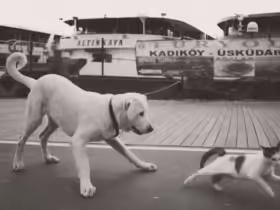Paddleboarding with Your Dog: A Step-by-Step Guide
Paddleboarding with your dog is a fantastic way to spend time outdoors while bonding with your furry friend. It combines adventure, relaxation, and exercise for both you and your dog. However, for a successful and safe paddleboarding experience, preparation is essential.
In this guide, we’ll cover everything you need to know to get started, from training your dog to feel comfortable on the board to essential safety tips and gear.
Why Paddleboarding with Your Dog is a Great Activity
Paddleboarding is not just for humans—dogs can enjoy the serenity of gliding across the water while engaging their muscles and minds. Here are a few reasons why paddleboarding with your dog is worth trying:
- Exercise for Both of You: Paddleboarding provides a full-body workout, while your dog gets to balance and occasionally swim alongside you.
- Strengthening the Bond: Sharing a new and challenging activity deepens the trust and relationship between you and your dog.
- Exposure to Nature: Paddleboarding often takes place in scenic areas, allowing both you and your dog to enjoy the beauty of nature.
- Mental Stimulation: Navigating the water requires your dog to remain focused and engaged, keeping their mind sharp.
Getting Started: Preparing Your Dog for Paddleboarding
Before hitting the water, it’s important to ensure your dog is ready for this new adventure. Here’s a step-by-step guide on how to prepare your dog:
1. Assess Your Dog’s Temperament
Not all dogs are suited for paddleboarding. Ask yourself these questions before starting:
- Is your dog comfortable around water? If your dog is anxious near water, they may struggle to enjoy paddleboarding.
- Does your dog have good balance? Paddleboarding requires your dog to maintain balance on a moving surface.
- Is your dog obedient and calm? Dogs who are overly excitable or easily distracted might have difficulty staying on the board.
If your dog is calm and enjoys the water, they’re likely a good candidate for paddleboarding.
2. Start with Basic Training
Before even touching a paddleboard, ensure your dog is well-trained with basic commands like sit, stay, and come. These commands are crucial for maintaining control while on the water.
Step-by-Step Guide: Training Your Dog for Paddleboarding
Now that you’ve prepared your dog, it’s time to train them for the real thing. Follow this step-by-step guide:
1. Introduce Your Dog to the Paddleboard on Land
Before heading to the water, allow your dog to get familiar with the paddleboard on dry land. Follow these steps:
- Place the board on the ground. Let your dog sniff it and walk around it.
- Encourage your dog to step on the board. Use treats or their favorite toy to coax them onto the board.
- Practice balance. Once your dog is comfortable standing on the board, gently rock it back and forth to simulate the movement of water. Reward your dog with praise and treats.
This step will help your dog become more familiar with the board, making the transition to water easier.
2. Practice in Shallow Water
After your dog is comfortable with the board on land, move to shallow water:
- Wade into shallow water with the board. Allow your dog to explore the water while keeping the board stable.
- Have your dog sit on the board while it’s near the shore. Make sure they’re calm and comfortable with the gentle motion of the water.
- Use treats to reward your dog. Positive reinforcement will help your dog associate the paddleboard with good experiences.
3. Gradually Move into Deeper Water
Once your dog is comfortable in shallow water, it’s time to take it up a notch:
- Slowly paddle out into deeper water. Keep your movements slow and steady to help your dog adjust.
- Monitor your dog’s behavior. If they seem stressed, head back to shallow water and try again later.
- Reinforce commands. Practice “sit” and “stay” to keep your dog focused and calm on the board.
Essential Gear for Paddleboarding with Your Dog
To ensure a safe and enjoyable experience, having the right gear is essential. Here’s what you’ll need:
1. A Stable Paddleboard
Not all paddleboards are suitable for dogs. Look for boards with the following features:
- Wider and more stable boards offer better balance for both you and your dog.
- Non-slip deck pads provide grip and comfort for your dog.
2. Dog Life Jacket
Even if your dog is an excellent swimmer, a dog life jacket is crucial for their safety. Here’s what to look for in a life jacket:
- Handles: Make it easier to lift your dog back onto the board.
- Bright colors and reflective strips: Improve visibility in the water.
- Proper fit: Ensure the life jacket fits snugly without restricting movement.
3. Leash and Harness
In case of emergencies, you may want to keep your dog on a leash, but never attach the leash directly to the paddleboard. Instead, use a floating leash and attach it to your dog’s life jacket or harness.
4. Water and Snacks
Keep your dog hydrated by bringing a collapsible water bowl and fresh water. Pack healthy snacks or training treats for rewards during the adventure.
Safety Tips for Paddleboarding with Your Dog
Safety should always come first when paddleboarding. Here are a few tips to keep in mind:
1. Know Your Dog’s Limits
Not all dogs will take to paddleboarding immediately, and some may never enjoy it. Watch for signs of stress such as excessive panting, shaking, or attempting to leave the board.
2. Start Slowly
Don’t rush the process. Start with short trips to build your dog’s confidence and gradually increase the length and distance of your paddleboarding outings.
3. Be Mindful of the Weather
Check the weather forecast before heading out. Avoid paddleboarding in strong winds, rough waters, or extreme heat. Always bring plenty of water to keep your dog hydrated, especially on hot days.
4. Stay Close to Shore
When starting out, it’s best to stay close to the shore in case your dog becomes anxious or tired. As your dog becomes more comfortable, you can venture farther into the water.
What to Do If Your Dog Falls Off the Paddleboard
Despite your best efforts, accidents can happen, and your dog might fall off the paddleboard. Here’s what to do:
- Stay calm. Panicking will only make the situation worse.
- Guide your dog back to the board. Use the handle on their life jacket to lift them back onto the paddleboard.
- Offer reassurance. Praise your dog to help them feel comfortable after the fall.
If your dog falls off multiple times or appears frightened, return to shore and try again another day.
Paddleboarding Etiquette: Sharing the Water with Others
When paddleboarding with your dog, it’s important to be mindful of other water users, including swimmers, kayakers, and fellow paddleboarders. Follow these tips for good etiquette:
- Keep your dog close. Avoid allowing your dog to swim out too far from the board.
- Respect other dogs and people. Not everyone is comfortable around dogs, so maintain a respectful distance.
- Clean up after your dog. Bring waste bags and ensure you leave no trace behind.
Conclusion: Ready to Paddleboard with Your Dog?
Paddleboarding with your dog can be an exciting and rewarding experience for both of you. With the right preparation, training, and gear, your dog will enjoy gliding across the water with confidence.











Leave a Reply